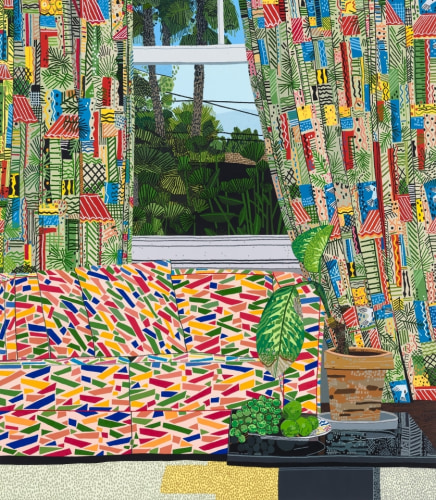
David Kordansky Gallery is pleased to present Plants and Animals, an exhibition of new paintings and works on paper by Jonas Wood. Occupying all three of the gallery's exhibition spaces, the exhibition will be on view January 22 through March 5, 2022. An opening reception will take place on Saturday, January 22 from 4 to 8 PM.
In Plants and Animals, Jonas Wood explores some of the most frequently recurring themes in his work, turning to a variety of formats and mediums to render images not only of flora and fauna, but also of detailed worlds of related forms, spaces, and moods. Wood foregrounds the processes of composition that are the driving forces in all of his pictures. The subtleties of scale, color, and visual texture that are found everywhere throughout this show, however, demonstrate both the evolving nature of Wood’s ideas and his ever-increasing commitment to his vision, including his passion for and preternatural understanding of the material elements of painting, drawing, and printmaking themselves.
The works in Plants and Animals were made over the last three years, and often are the results of evolving studies that go back even further than that. Wood has long turned to subjects that attract him for their personal relevance and formal idiosyncrasy. To make paintings, he works from photographs, drawings, and collages; in technical terms, his sources often combine several of these approaches as well as varying degrees of mediation, with Wood developing his ideas according to principles that are as informed by abstract notions of pattern and shape as they are by representational fidelity.
Imagery from one work often appears in others, highlighting the ways in which Wood’s ideas go through these several phases of development. In some paintings, he establishes anachronous juxtapositions, inserting family members into images he finds on the internet or compiling entirely fictional scenes out of otherwise factual elements drawn from diverse sources. What unifies these diverse elements are Wood’s increasingly nuanced approaches to color and paint application. While many of the paintings are notable for their saturated hues and bold forms, they all contain innumerable instances in which less immediately perceptible decisions play key roles in the paintings’ overall effect. Woven throughout some pictures, for instance, are carefully modulated grey and neutral tones that generate palpable volume.
The teeming detail that defines many works in Plants and Animals has visual as well as physical functions. Whether he is rendering images of densely patterned textiles, thick dog fur, or large-scale, foliage-packed landscapes, Wood produces each painted mark with remarkable clarity and intention. Density, therefore, becomes paradoxically responsible for imbuing the compositions with vibrating luminosity, even as it roots their presence in the material world. Wood gives every mark, no matter how small, an indelible feeling, character, and shape. He pays special attention to the viscosity and structure of the oil medium, which allows the eye to perceive these marks as carriers of color as well as instances of material invention in their own right.
Each of these characteristics reveals Wood’s project to be one in which craft and process go hand-in-hand with psychological connection and overall pictorial vision. The works on paper that constitute an essential part of Plants and Animals shed further light on the elaboration of these various modes of thought, intuition, and production. They also demonstrate the artist’s breadth and curiosity: he employs various types of printmaking to create a range of effects and moods, and experiments with varying approaches to layering and foreground/background distinctions. The exhibition provides viewers with many opportunities to follow Wood as he examines an idea from numerous perspectives, rendering it in different mediums and altering its feel and scope as he responds to their possibilities and demands.
What arises from all of these works, whether on canvas or paper, are images of life as remembered, imagined, invented, and observed. But as plants and animals often do for those who appreciate them, their subjects also speak to a deeply felt curiosity about—and affection for—the natural world. Deeply personal on the one hand and capable of generating broad appeal on the other, Wood’s pictures are antithetical to the kinds of separation and distance that mark so many attempts, artistic or otherwise, to analyze or represent the phenomena of daily life. They are testaments, rather, to what happens when art becomes another living phenomenon, as vivid and responsive as the things it depicts—and as able to elicit emotion from the humans who experience it.
Paintings by Jonas Wood (b. 1977, Boston) are currently on view through April 3, 2022 at The Broad in Los Angeles in the group exhibition Since Unveiling: Select Acquisitions of a Decade. Wood has been the subject of solo and two-person exhibitions at the Dallas Museum of Art (2019); Museum Voorlinden, Wassenaar, the Netherlands (with Shio Kusaka, 2017); Lever House, New York (2014); and Hammer Museum, Los Angeles (2010). Other solo projects include Still Life with Two Owls, a monumental picture covering the façade of The Museum of Contemporary Art, Los Angeles (2016—2018); Shelf Still Life, High Line Billboard, High Line Art, New York (2014); and LAXART Billboard and Façade, LAXART, Los Angeles (2014). Other recent group exhibitions include Psychic Wounds: On Art and Trauma, The Warehouse, Dallas (2020); One Day at a Time: Manny Farber and Termite Art, Museum of Contemporary Art, Los Angeles (2018); and Los Angeles: A Fiction, Astrup Fearnley Museet, Oslo (2016) and Musée d'art contemporain de Lyon, France (2017). His work is in the permanent collections of many institutions, including the Hirshhorn Museum and Sculpture Garden, Washington, D.C.; Hammer Museum, Los Angeles; Metropolitan Museum of Art, New York; San Francisco Museum of Modern Art; Guggenheim Museum, New York; The Broad, Los Angeles; Museum of Modern Art, New York; and Whitney Museum of American Art, New York. In 2019, Phaidon published the first monograph dedicated to Wood’s paintings and drawings. Wood lives and works in Los Angeles.